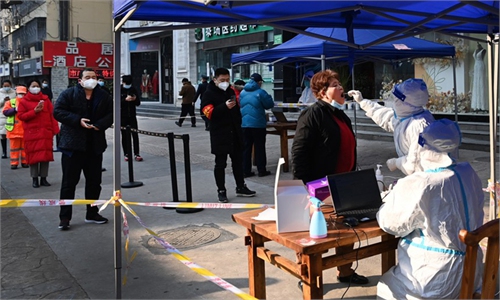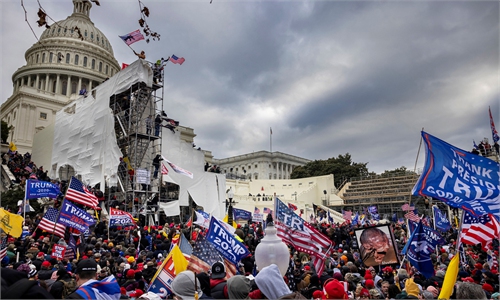IN-DEPTH / IN-DEPTH
US govt’s failed epidemic response leaves Chinese Americans to fend for themselves amid Omicron surge
Nowhere to turn
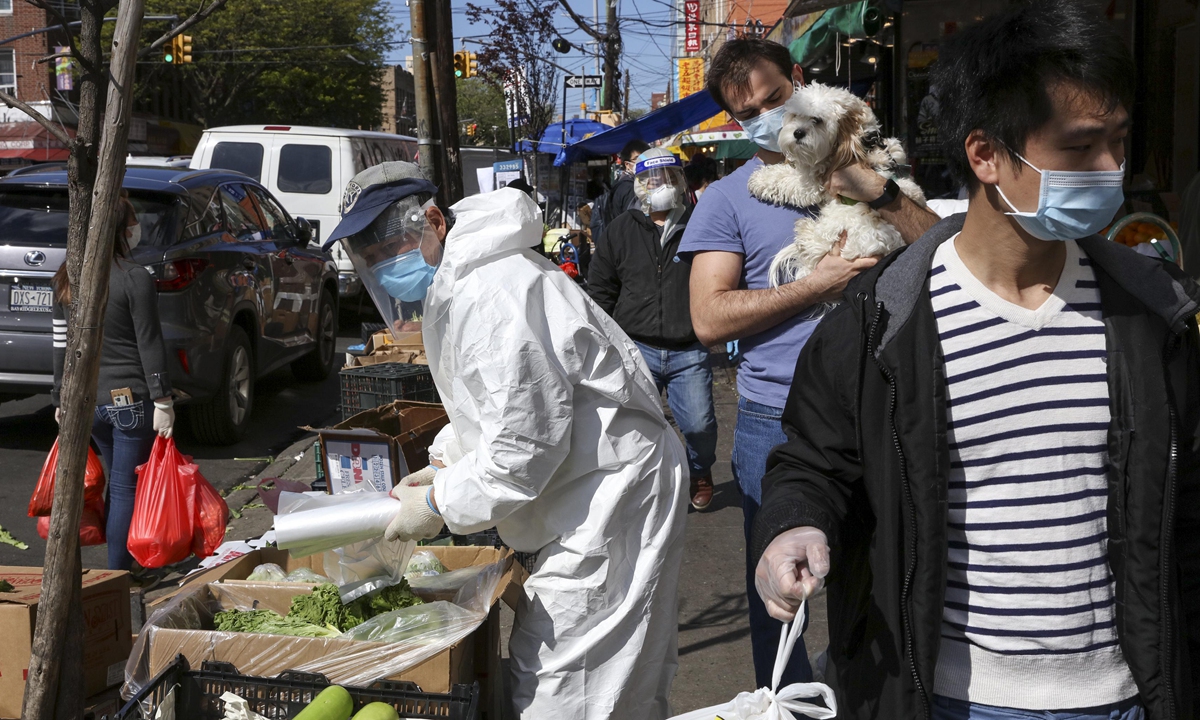
In the Chinese community in Brooklyn, New York, a street vendor wears a protective suit to sell vegetables with pedestrians in masks and other personal protection equipment on May 12, 2020. Photo: VCG
In the US, after two years since the COVID-19 pandemic hit the world, Chinese Americans who used to feel proud that "no one in the Chinese community was infected" are struggling to cope with the reality that they could get infected at any minute in a country where the government's tragic mishandling of the COVID-19 pandemic has led to countless disasters and loss of human life."We need to prepare ourselves, everyone will catch COVID-19" has become the mantra of this cautious and rational group in epidemic prevention in the country, as the US government seems to be incapable of doing anything in the face of the onslaught of Omicron and Delta, mutated COVID-19 strains.
On January 3, after the Christmas and New Year's holidays, the US saw 1.02 million new cases confirmed within 25 hours.
According to statistics from Johns Hopkins University, as of January 10, the total number of confirmed COVID-19 cases was over 60 million, and the death toll stood at over 837,664.
Chinese Americans who have been struggling for more than two years have seen their friends and relatives get infected one after another in recent days. As medicines at pharmacies are snapped up, COVID-19 tests are in short supply and confirmed cases continue to break records, they feel helpless.
From being full of confidence to now being deep in despair, Chinese Americans were only a fragment of the harsh reality displayed in the US society. Their persistent efforts have proven futile.
In the face of a new wave of fast-spreading epidemic, the US government still seems intent on letting things slide without taking effective measures to tame the virus, but instead intensifies its slander and attack against China's effective and scientific epidemic prevention and control efforts.
Observers and experts reached by the Global Times said that the US' passive epidemic response has led to dreadful consequences, which could have an impact on human history. The US government has had to fabricate lies to divert attention because of its inability and inefficiency.
Futile struggle
"Right now in the US, many people are either confirmed cases or are close contacts of infected people," Lam Hui, 56, a Chinese American living in the San Francisco Bay Area, told the Global Times.
For the past two years, Lam's family has taken adequate precautions to try to avoid contracting this unpredictable and dangerous virus. However, unfortunately in mid-December, her mother was infected by a plumber who came to fix the plumbing. Then her husband and son were also confirmed. Lam, the only one in the family who tested negative, temporarily moved to the guest room, which became both her fortress and a lonely island.
"I was devastated when three of our family members tested positive, but I still had to pretend to be calm and drive out in the middle of the night to get more medicine. But after running to three pharmacies and seeing empty shelf, I couldn't hold back my tears anymore," she said.
Fortunately, the symptoms of Lam's infected family members were mild, with only cough and mild fever. During their home isolation, they actively traced the source of the virus that had infected them, and reported their symptoms in several Chinese-American community WeChat groups.
But what made them feel helpless was the increasing number of such "reports" in their chat groups, where they even learned that there were reports of certain fake coronavirus disease testing sites popping up in San Francisco that had further rattled people's nerves.
"Since the outbreak, Chinese Americans have undoubtedly been the most cautious group in the US. We try hard not to add trouble to the community we live in, but unfortunately, we cannot prevent the extensive infection due to the indifference of the whole society," Lam sighed.
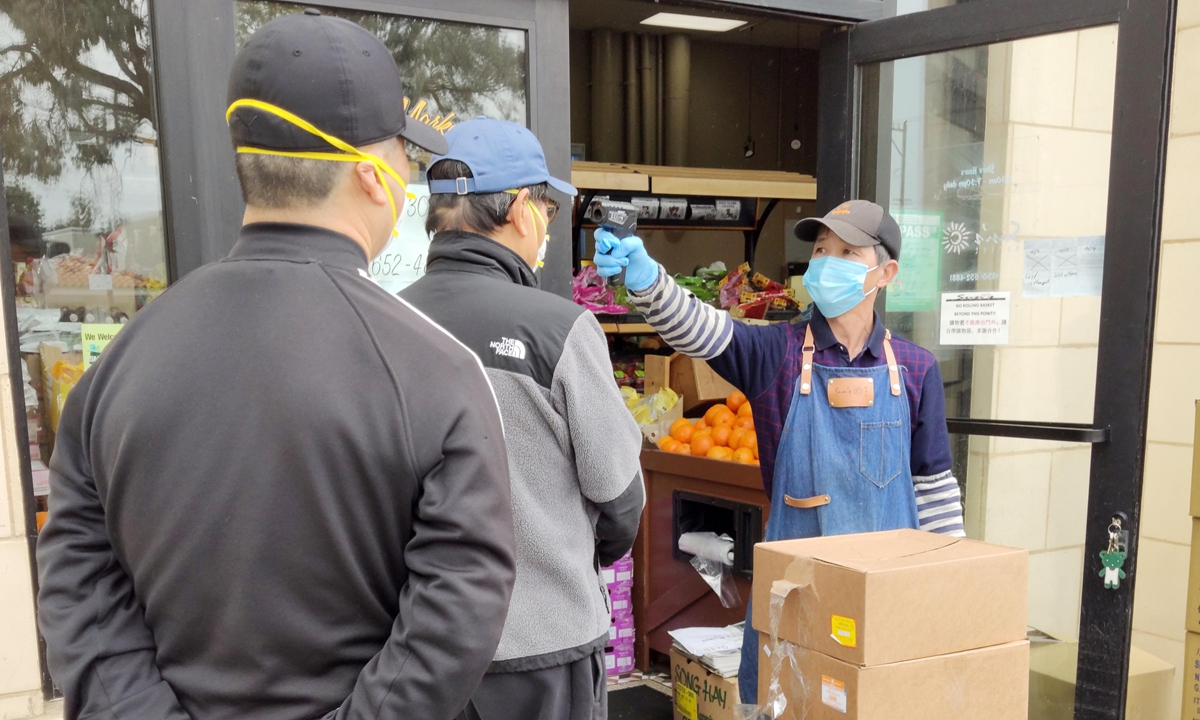
An employee at a Chinese supermarket in San Francisco Bay Area takes the temperature of each customer on April 16, 2020. Photo: VCG
Many Chinese people are aware of the flaws inherent in US politicians and media reports' narratives that COVID-19 is a severe form of influenza - currently, many COVID-19 patients have serious complications, and many more still get a positive test results after infection, Choi Jingwen (pseudonym), an attending pathologist working at New York Harbor Healthcare System told the Global Times."The Chinese American residents are still very cautious about this virus, because our current understanding of COVID-19 is so incomplete. There is no sufficient evidence to prove that people are free from the side effect even after they recover from infection," Choi added.
According to Healthline, a US website that provides health information, new research shows that severe COVID-19 may significantly damage long-term health, patients with severe COVID-19, even after recovery, run twice the risk of dying in the first year of illness as compared to people who haven't suffered from a severe case.
"I will never forget the video footage earlier [in the epidemic] of the bodies of COVID-19 patients being dumped randomly by a river in New Jersey," Lam said.
Chaotic situation
At the time of the interview with the Global Times reporter, Jack Chen, a PhD student at the University of Chicago, was still suffering from a fever. With fever-reducing drugs having not been working, he didn't even have the strength to go downstairs to get the virus test strips that his family had sent him, but he was even more anxious when he thought of the experiment at his school's lab that couldn't be suspended and would start in just a few days' time.
"I don't know when I may get infected. I have avoided every communal activity that could lead to infections," Chen told the Global Times, noting that many of his classmates also got infected, but the school still encouraged them to attend classes.
Chicago is not alone in encouraging students to return to school after a mass infection outbreak over the holidays.
Another PhD student surnamed Zhang in a university in Georgia, has been preparing for the upcoming semester. Due to the school's request, she has to go to campus from next Monday.
In the past two weeks, Zhang has heard about a dozen Chinese pals confirmed to be infected with the virus. "Two years ago, I had never heard of a single case of any Chinese person I know getting infected."
What aggravates her anxiety is that the school only "advises" rather than requires that people entering campus buildings get vaccinated or wear a mask. "I have stocked stuffs up and get prepared for being infected any time," she told the Global Times.
Meanwhile, in recent days New York State has continued to experience record numbers of COVID-19 infections and a surge in hospitalizations, among which, children ages 18 and younger hospitalized with COVID-19 complications increased by more than 700 percent over just the last month, local media reported.
However, newly elected New York City's mayor, Eric Adams, insisted that the city's public schools must remain open to keep children in school, repeatedly claiming that schools are the "safest place" for children, CNN reported.
To date, the US' anti-epidemic response can be described as a complete failure, Lü Xiang, a research fellow on US studies at the Chinese Academy of Social Sciences in Beijing told the Global Times, noting that the US CDC has played virtually no meaningful role in the entire process.
"I feel that the US government cares more about the impact on the economy. Human lives are not the priority, and as long as the epidemic does not cause panic, the government is okay with that," Zhang said.
However, the recent surge in mass infections has brought a series of "complications" to the US society. Lam said that since the outbreak, the US government has blindly pursued policies that have caused prices to rise by at least 20 percent, and reckless welfare payments have led to a wave of job losses, with many people preferring to stay home waiting for their social security checks instead of going to work. "The caregiver I hired to care for my mother has already not come to work for several months."
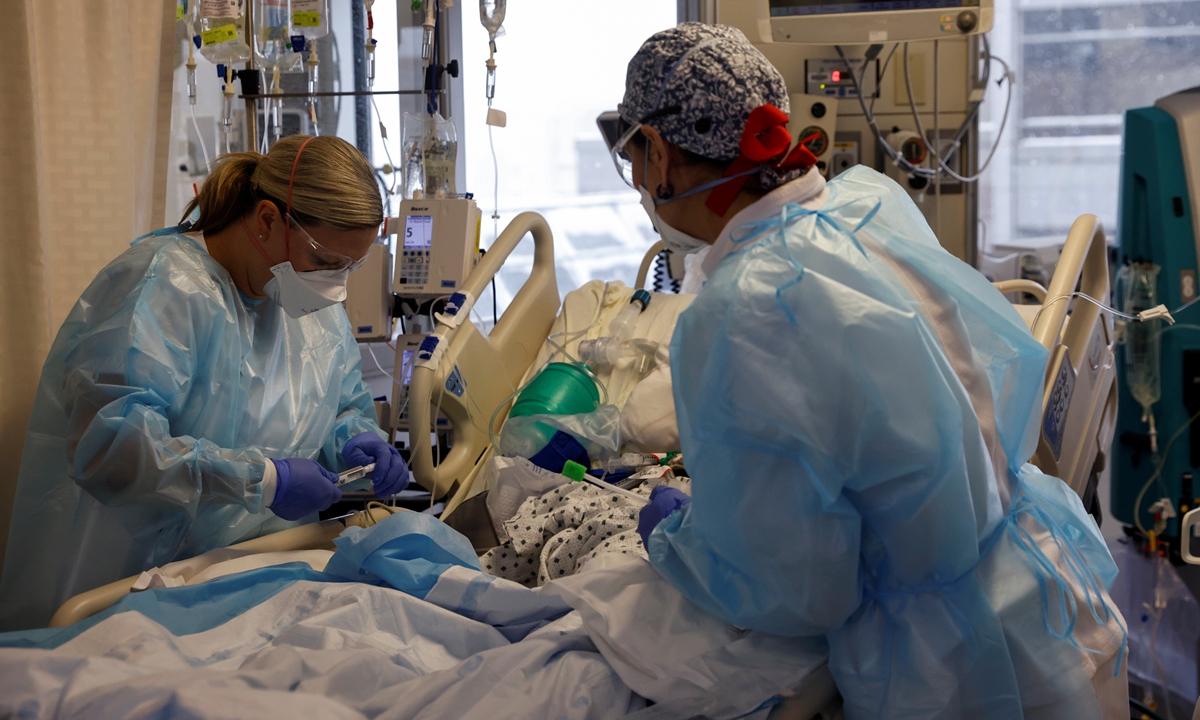
Medical staff treat a COVID-19 patient in the Intensive Care Unit at the Cleveland Clinic in Cleveland, Ohio on January 7, 2022. Photo: VCG
To make matters worse, hospitals across the US have been overwhelmed by soaring COVID-19 cases, forcing them to postpone or suspend elective surgeries to free up staff and beds.According to Reuters, hospital systems in nearly half of all US states, including Maryland, Virginia, and Ohio, have announced they will delay elective surgeries.
"At present, Chinese Americans with other diseases are also conducting self-care at home. They are concerned about increasing the risk of infection in the hospital, but they also worry that they will unfortunately develop more severe diseases and ultimately receive no treatment," Choi said.
This passive epidemic control response is inhumane, setting a very bad example for other countries, and could even affect the fight against infectious diseases that humanity will face in the future. Lü said.
Divert attention
As Chinese Lunar New Year approaches, the most frequent messages from Chinese Americans in WeChat groups convey their longing for their home countries and their admiration of China's safe and stable social environment.
However, Chinese Americans were shocked that Western media outlets, in the face of the mess in their own country, still blindly blamed China, continuing to question China's "dynamic zero" COVID-19 policy which they criticized as being "extremely costly" and a "waste of resources."
We can see how the US media continue to hype the threat that sporadic outbreaks pose to China and attack China's anti-epidemic efforts, Alice Huang, a New York resident and a naturalized American citizen for 5 years told the Global Times.
"The problems that emerged in China during the fight against the epidemic were mainly individual cases that could be caused by problems in grassroots management, while the great chaos and turmoil of the entire US society stemmed from its system," she said.
It has long been a common tactic of US politicians to smear the achievements of other countries and even make up lies about them to divert the attention of the American public from domestic issues, Lü pointed out.
It is not that the US government is unaware of the seriousness of the epidemic. However, due to systemic flaws, partisan battling and pressure from the upper class of the society, they were unable to control the epidemic and fabricated lies to cover it up, leading Americans and even the West to believe that China's success or flaws are both the result of an "authoritarian system," Lü noted.
"But back home, the 800,000 death toll is just a number to them, and the mourning ceremonies are just a political show," he said.
